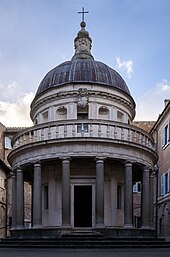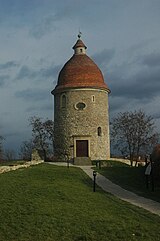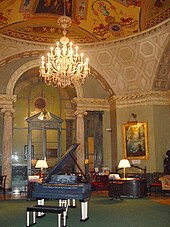Rotunda (architecture)
This article includes a list of general references, but it lacks sufficient corresponding inline citations. (August 2011) |

A rotunda (from
Classical architecture

The terminology of
The few large Greek tholoi had varied functions, not all of which are now clear. Several are at major religious sanctuaries, but seem not to have been conventional temples. At most only the foundations and a few columns remain in place. They include the
The oldest, the Tholos of Athens, was a large and plain rotunda used as a dining hall, and perhaps more, by the city's ruling council.[3]
Later, very large, Roman rotundas include the
India
Some of the earliest free-standing temples in India are thought to have been of a circular type, as the Buddhist
It has been suggested that these circular structures with colonnades may have originated with the Greek circular tholos temple, as in the Tholos of Delphi, but circular wooden huts in India are a more likely source of inspiration.[6]
-
Remains of a circular Chaitya, Tulja Caves
-
Tulja Lena Chaitya, plan and elevation
-
Sanchi depiction of the Mahabodhi Temple
-
Reconstruction of the Bairat Temple
Medieval and Renaissance Europe

The
The rotunda with columns was revived in one of the most influential buildings in Renaissance architecture, the Tempietto in a courtyard of the church of San Pietro in Montorio in Rome. This was designed by Donato Bramante around 1502 in strongly classicizing style. It is a small building whose innovation, as far as Western Europe was concerned, was to use the tholos form as the base for a dome above; this may have reflected a Byzantine structure in Jerusalem over the tomb of Christ. The Roman Temple of Vesta (which has no dome) was probably also an influence. This pairing of tholos, now called a drum or tholobate, and dome became extremely popular raised high above main structures which were often based on the Roman temple.[7]
Rotunda in Central Europe
A great number of
-
The famousRotunda church in Thessaloniki, Greece
-
The most well known Danish rotunda is the village parochial church at Østerlars.
-
Rotunda in Starý Plzenec, Czech Republic from the 10th century
-
St. Nicholas Rotunda in Cieszyn, Poland, 11th or 12th century
Rotunda in the Carpathian Basin

Several types of rotundas are found in the
-
Romanesque village church in Selo, Slovenia
-
Rotunda, Öskü, Hungary
-
Rotunda, Kiszombor, Hungary
-
Rotunda rebuilt into bigger church in Szalonna, Hungary
-
Great Moravian rotunda of St. George. Nitrianska Blatnica, Slovakia
-
Rotunda of St. Margaret the Virgin in Šivetice, Slovakia; the biggest rotunda in Central Europe
-
Foundations of Great Moravian rotunda in Kostolec gord in Ducové, Slovakia
The Caucasus
There is an interesting connection between Central European and Caucasian rotundas of the 9th to 11th centuries AD. Several Armenian built rotunda churches have sixfold arched central apsis, i.e. at Aragatz,
Good example of Georgian rotunda church is Bana cathedral which is now located on territory of Turkey.
East Asia
- Temple of Heaven construction completed on 1420 during Yongle Emperor who also constructed Forbidden City of China
- Hakka in Fujianregion of China. They are built between the 12th and the 20th centuries.
-
Hall of Prayer for Good Harvests, the largest building in the Temple of Heaven
-
Tianluokeng tulou cluster
-
Sanchi Stupain India, a Buddhist pilgrimage site
-
4 concentric ring architecture of Chengqi lou
Notable rotundas


Religious buildings
- Baptistery at the Piazza dei Miracoli, Pisa, Italy
- basilicainformally named Santa Maria della Rotonda
- Santo Stefano Rotondo, Rome
- The Church of the Rotonda in Tomb of Galerius" in 306 AD
- , a 4th-century Early Christian church
- St. George Cathedral Church at Zvartnots, Armenia
- St. Martin's Rotunda in Vyšehrad Castle, Prague, Czech Republic
- Rotunda of Saint Catherine in Znojmo, Czech Republic
- St. Alexander's Church in Warsaw, Poland
- Rotunda of St Marija Assunta in Mosta, Malta
- Temple Church in London
- Chausathi Yogini temples at Morenain India
- Willmette, Illinois, US
- The Rotunda in Aldershot in the UK, built in 1876 and demolished in the 1980s
Buildings for entertainment
- Ranelagh Gardens in London, built in the 1740s and demolished in 1805. It was painted by Canaletto.
- Pantheon, London, opened 1772, demolished in 1937.
- The leisure centre at St Helier, Jersey, a regular venue for shows, concerts and events
- The internal Rotunda in the Michael Maddox Petrovsky Theatre, Moscow (burnt down in 1805).
- Gate Theatre in Dublin, Ireland (formerly part of the Rotunda Hospital, built in 1757).
- turntable engine shed, it was used as a ginstore till being converted into a theatre in the 1960s.
- Royal Albert Hall in London, England.
- IMAX Theatre in London, England.
- The Jackie Robinson Rotunda at Citi Field.
- Romanian Athenaeum in Bucharest. It is a concert hall and a landmark of the Romanian capital city. Opened in 1888, the ornate, domed, circular building is the city's main concert hall and home of the "George Enescu" Philharmonic and of the George Enescu annual international music festival.
- Ohio Stadium in Columbus, Ohio, built in 1922
- Tsarskoe Selo, Russia architected by Francesco Bartolomeo Rastrellihad a rotunda interior
Residential buildings
- .
- Ickworth House in Suffolk, England.
- Mereworth Castle in Kent, England.
- The Rotunda in Birmingham, England, built as an office building in 1964.
- The Rotunda Building, Norfolk, Virginia, rebuilt in 2007.
Buildings for learning
- The Radcliffe Camera, Oxford, completed in 1748.
- The Rotunda at the University of Virginia built in 1826.
- British Museum Reading Room, London, built in 1857.
- The Rotunda Museum, Scarborough, North Yorkshire.
- The Central Library, Manchester.
- Dallas, Texas, built in 1911.
- Grawemeyer Hall at the University of Louisville, built in 1926.
- Stockholm Public Library, Stockholm, built in 1928.
- Umeå University, Umeå, built in 1972.
- Cincinnati Museum Center at Union Terminalbuilt in 1933.
- Science Museum of Virginia built in 1919
- Vanderbilt University's Wyatt Center.[11]
- Drew University's Dorothy Young Center for the Arts built in 2002, and opened in 2003.
- The Campus Activity Centre at Thompson Rivers University, Kamloops, British Columbia.
- Ruffner Hall at Longwood University[12] built in 1839, reconstructed in 2004
Government buildings

- San Francisco City Hall
- New Zealand Parliament Buildings
- California State Capitol Rotunda[13] in Sacramento, California.
- Library of Parliament, a library for Canadian Parliamentarians. The only component of the Centre Block of Parliament to survive the 1916 fire
- The Rotundas, Marsham Street, a subterranean structure in Marsham Street in London
- The Samsad Bhavan, or the federal Parliament of India, in New Delhi
- San Jose City Hall rotunda in San Jose, California, an all-glass, postmodern structure
- United States Capitol rotunda
- West Virginia State Capitol
- Wisconsin State Capitol Rotunda[14]
- Vermont State Capitol
Commercial buildings
- Capitol Records Building in Hollywood, Los Angeles, California
- PKO Rotunda, Warsaw, Poland
See also
- Rotunda (disambiguation)
References
- ^ Lawrence, 183-188
- ^ Lawrence, 183-188
- ^ Lawrence, 183
- ^ ISBN 9780984404308.
- ^ "Sowing the Seeds of the Lotus: A Journey to the Great Pilgrimage Sites of Buddhism, Part I" by John C. Huntington. Orientations, November 1985 pg 61
- ISBN 9780984404308.
- ^ Freiburg, Jack, "Temple, Tabernacle, and Sepulchre: The Legacy of Bramante’s Tempietto", Sacred Architecture Journal, Vol 39, 2021; Summerson, 41–42; Loth
- ^ Dorica, Jozef (2018-01-05). "Rotunda sv. Juraja je zrejme najstaršou zachovanou sakrálnou stavbou v strednej Európe". Denník N (in Slovak). Retrieved 2020-04-05.
- ^ Podolinský, Alexandra; Podolinský, Štefan. "Nitrianska Blatnica". apsida.sk (in Slovak). Retrieved 2020-04-05.
- ^ "Šivetice, Rotunda sv. Margity Antiochijskej – Gotická cesta" (in Slovak). 27 October 2018. Retrieved 2020-04-05.
- ^ "Sitemason Outage". vanderbilt.edu. Archived from the original on 2011-09-27.
- ^ "Ruffner Hall". longwood.edu.
- ^ California, California State Parks, State of. "California State Capitol Museum". CA State Parks. Retrieved 3 April 2018.
{{cite web}}: CS1 maint: multiple names: authors list (link) - ^ http://tours.wisconsin.gov/pub/Content.aspx?p=Photo Tour - Rotunda
- Lawrence, A. W., Greek Architecture, 1957, Penguin, Pelican history of art
Further reading
- Vera, Gervers-Molnár (1972): A középkori Magyarország rotundái. (Rotunda in the Medieval Hungary). Akadémiai, Budapest
- József, Csemegi (1949): A tarnaszentmáriai templom hajójának stíluskritikai vizsgálata. (Studies on the Nave of the Church at Tarnaszentmária.) in: Antiquitas Hungarica III (1949), 92-107.
- Osterlar Church in Danmark Osterlar Church





















